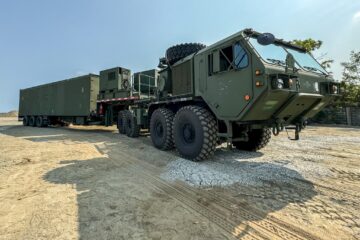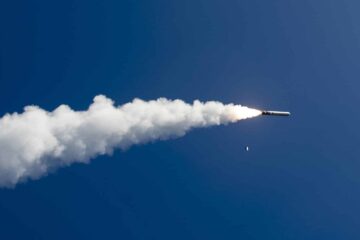Note that all of these U.S. rockets and missiles have been advertised as having Anti-Ship capabilities except for the CPS.
The Naval Strike Missiles (NSM)

The Marine Corps’ Navy Marine Expeditionary Ship Interdiction System (NMESIS) mounts two Naval Strike Missiles (NSM) on a remote-operated, driven, and NSM launched unmanned Joint Light Tactical Vehicle (JLTV) 4×4 vehicle. More information can be found here. The 900-pound (410 kilogram) NSM (or 910 pounds with booster) can be internally loaded aboard a CH-53 and onto the flatbed of a Medium Tactical Vehicle Replacement (MTVR) 6×6 truck via a forklift. Defense Visual Information Distribution Service (DVIDS) photos show that it is possible to push an NSM container on a trolley cart but loading it onto the JLTV will require a frontloader or forklift.


The Tomahawk Land Attack Missile (TLAM)

The USMC is fielding TLAMs on M872 trailers as part of a land-attack capability. With the Maritime Strike Tomahawk’s seeker, this Block 5A programable-in-flight cruise missile can be directed to target moving enemy ships. High-subsonic speed TLAMs have a range in excess of 1,000 miles (1,609 kilometers) and can be launched from Navy ships and submarines via Mark 41 Vertical Launch System (VLS). USMC trailers on land will use a derivative of the Mark 41 VLS. The Mark 41 can also fire Standard missiles for Anti-Air, Anti-Ship, and Anti-Land strike.
The Conventional Prompt Strike (CPS) Hypersonic Missile

The U.S. Navy’s 0.87-meter Conventional Prompt Strike (CPS) hypersonic missile is too large to fit inside the Mark 41 and Mark 57 VLS cells. Currently, there is no indication that the 0.87-meter CPS has an Anti-Ship capability. Furthermore, unlike the tactical Tomahawk, the U.S. Marines have not disclosed that they will add CPS to their truck fleet for land or sea-based trailer launch. The CPS hypersonic missile has a range in excess of 1,725 miles (2,776 kilometers) and a speed in excess of Mach 5+.
DARPA’s OpFires may be a candidate for the USMC as a more mobile form of firing hypersonic missiles transported, erected, and launched from a Logistics Vehicle Replacement System (LVSR) 10×10 truck, sans trailer, for much better mobility and to prevent trailer jackknifing, clearing setup, and launch.

High Mobility Artillery Rocket System (HiMARS)

The HiMARS rocket pods (six rockets to a HiMARS) are loaded onto a modified USMC Family of Medium Tactical Vehicle (FMTV) 6×6 truck for transport and launch. More information on HiMARS rockets can be found here and here. With new seekers, HiMARS’ rockets may be able to target moving enemy ships.







